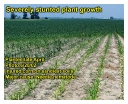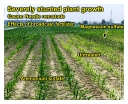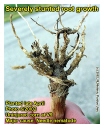

![]() everal weeks ago, I offered my two cents’ worth on
some of the causes of the yellow, stunted corn in
early-planted fields throughout the northern third of Indiana this spring.
With this article, I want to reinforce the notion that a number of stresses are
to blame this year and that every situation likely results from a different set
or combination of stresses. That is the reason why the recuperation of these
plants has been so variable from one field to the next.
everal weeks ago, I offered my two cents’ worth on
some of the causes of the yellow, stunted corn in
early-planted fields throughout the northern third of Indiana this spring.
With this article, I want to reinforce the notion that a number of stresses are
to blame this year and that every situation likely results from a different set
or combination of stresses. That is the reason why the recuperation of these
plants has been so variable from one field to the next.
Stunted plants in some fields have recovered nicely, while in other fields the plant appearance has scarcely improved, while in other fields the plants eventually died. Rescue applications of various fertilizers (including ammonium sulfate, magnesium sulfate, manganese sulfate, 28% UAN, anhydrous ammonia) have either improved plant appearance dramatically, some, or not at all compared to untreated areas of the field.
Field location is one of the first clues in determining the likely causes of the stunting. In some fields, the plant stunting occurred in the lower, poorly drained areas and was accompanied by significant stand loss. Seed rot and/or seedling blight were the most frequent causes of the problem in these fields, encouraged by the slow initial pace of corn development that delayed the successful establishment of the nodal root system.
 ] [
] [
 ]
]In other fields, the stunted corn was most frequently located in the sandiest, seemingly better drained, areas of the fields. Plant stunting and yellowing were visually dramatic, but not what you call severe. With the warm-up that began in late May, many of these fields have recovered to some extent on their own. Causes of the stress in these fields was some combination of cool weather, lower than desired soil pH, minor seedling blight, and leaching of mobile soil nutrients such as nitrogen and sulfur below where the young corn plants’ root systems could yet explore.
Other, more severe, cases of stunted, yellow corn in sandy soils have not recovered well. In addition to the severely stunted above-ground plant parts, the root systems of these plants are also severely stunted and/or malformed in their development. In some cases, the root symptom was similar to that which we used to attribute to trifluralin (Treflan) carryover when that herbicide was commonly used in soybean. Interestingly, seedling blight was also evident on the mesocotyl and seed roots of many stunted plants in the sandy areas as well as an interesting yellow discoloration of the roots.
Potential causes of the severe stunting in these sandy areas include leaching from frequent heavy rains of nitrogen and/or sulfur below the extent of the young plants’ root systems, compaction of seed bed or furrow sidewalls by tilling or planting “on the wet side” (yes, sand will compact!), sandblasting injury to young plants during windy days, extremely low soil pH, and corn nematodes. The latter cause is one that I frankly rarely consider when troubleshooting stunted corn, but I have learned this spring that it can be a significant stress to young corn plants under the right (or wrong) conditions.
 ][
][
 ]
]I submitted a plant and soil sample taken from a severely stunted area of corn on a sandy knoll in northwest Indiana to Purdue’s Nematology Laboratory late last week which was subsequently diagnosed as being severely infested with needle nematodes. Injury from corn nematodes is not unheard of in sandy soils of northern Indiana, but is particularly encouraged by lengthy periods of wet and cool soils when young corn (emergence to V3) is developing very slowly. Additional stress to the plants by low soil pH (low 5’s or less) and nutrient deficiencies (albeit even if temporary) further limits the young plants’ abilities to “outgrow” the damage caused by the nematodes. The additional stress caused by the recent hot and dry conditions further stressed the already limited root systems and limited the plants’ abilities to recover.
Jamaal Faghihi (jamal_faghihi@entm.purdue.edu) forewarned us back in early May that conditions were ripe for nematode damage to corn (P&C Newsletter, 3 May). Information about needle nematodes can be found in Purdue Extension publication E-215 available at your local county Extension office or on the Web at http://www.entm.purdue.edu/Entomology/ext/targets/e-series/EseriesPDF/E-215.pdf (verified 6/25/02).
 ][
][
 ][
][
 ]
] For other
information about corn, take a look at the Corn Growers Guidebook on the World
Wide Web at http://www.kingcorn.org
For other
information about corn, take a look at the Corn Growers Guidebook on the World
Wide Web at http://www.kingcorn.org